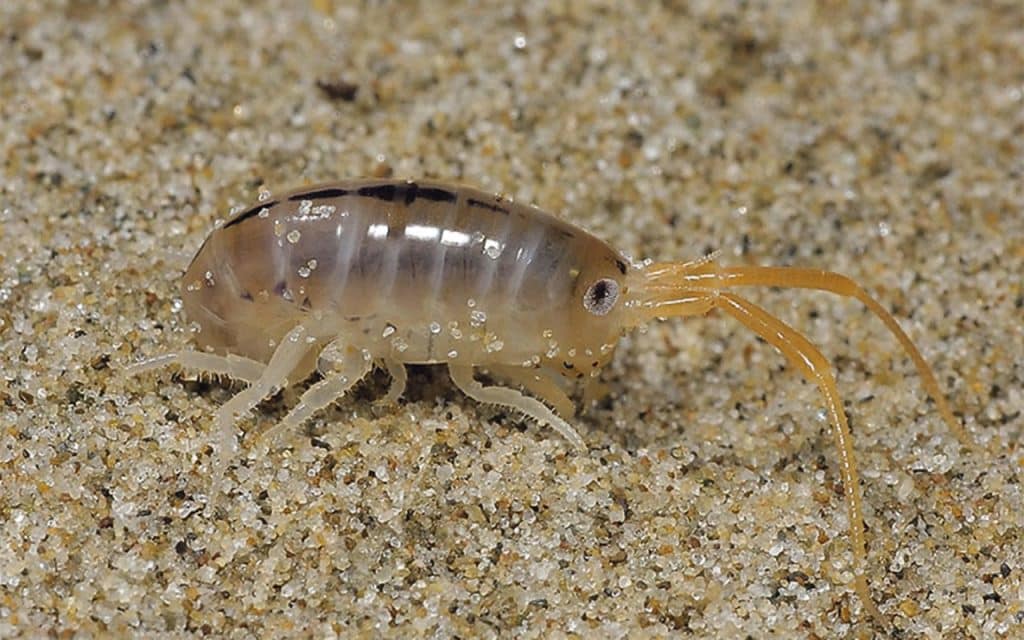In 2024, I collected 51.74 kilograms of litter from the cove at the end of our lane. That is more than in 2022 and 2023, but a little less than in 2021. Fishing gear such as ropes and hard plastic floats were the heaviest items, but plastic bottle pieces were, as always, by far the most abundant, found in 97 per cent of collections.
While I was sorting through the rubbish a few weeks ago, a sandhopper leaped out from the jumble of debris. Not many people would notice such an insignificant animal; many wouldn’t even know what it was. My immediate thought was to return it to the beach – a 15 minute walk, just for a sandhopper. But I did, and released it beside a clump of dead seaweed, under which dwelt hundreds of other sandhoppers. It either lived happily ever after, which for a sandhopper is not long, or it got eaten by a rock pipit or pied wagtail.

You might think I am mad – why bother about such a small thing? But without the small things, there would be no big things. Everyday survival is hard enough for most creatures, without humans disturbing them. If people took the time to observe animals, even the most humble, to appreciate and understand them, and to consider them not as annoyances or commodities, but as individuals with a right to life, then the world would be a much better place.
Sandhoppers are crustaceans, part of the huge phylum Arthropoda, animals with exoskeletons and jointed legs. This also includes insects, spiders and scorpions, millipedes and centipedes, ticks and mites – all the ‘creepy-crawlies’ that usually produce screams of horror or disgust. But arthropods should be admired – they are the most numerous and important animals on the planet.
Crustaceans are distinguished from the other arthropods mostly by their limbs, which are modified for different functions, for example walking, paddling, or grasping food. They also have gills, and so they must live in water, or at least in damp places. Some crustaceans are tiny, such as the cladocerans (‘water fleas’), fairy shrimps, ostracods and, perhaps the most numerous of planktonic animals, the copepods; an accidental mouthful of sea water might contain dozens of copepods. Then there are barnacles, which some might think are molluscs, but they aren’t; krill, which look like shrimps, but aren’t; isopods (woodlice and sea slaters), and the big decapods with which we are all familiar – the true shrimps, lobsters and crabs.
Sandhoppers belong to another important group of crustaceans – the amphipods. There are about 10,000 described species of amphipod. Most are marine, some are found in freshwater, and a few are terrestrial, living in the sand or even soil above high water mark. They range in size from a few millimetres to the seven centimetre long Acanthogammarus victorii, endemic to Lake Baikal, and Alicella gigantea, which lives in the very deepest Atlantic and Pacific abysses and can grow to over 30 centimetres.
Amphipod species are notoriously difficult to identify; a former head of Zoology in UCC, Professor Alan Myers, is one of the world’s leading amphipod experts. There are four main groups in the order: the sandhoppers and their relatives (sometimes misnamed ‘sand fleas’); the ghost shrimps and whale lice; the pelagic amphipods that swim in the plankton; and some obscure deep-sea ones that need not concern us here.
Sandhoppers are among the most abundant animals on the sea shore. If you lift up some seaweed when you are cleaning a beach (which, I am sure, you all do regularly), many of these little creatures will jump out. Walking barefoot at the water’s edge on a warm summer’s night, you might also feel them hopping onto your toes. A sandhopper is laterally flattened so that it appears to crawl on its side, and it has legs of different shapes and sizes: the first two pairs have claws, the next two pairs are quite short, the last three pairs are long and point backwards. There are also leg-like appendages on its abdominal segments (like the little paddles on the abdomen of a lobster). With all these different types of legs, sandhoppers can crawl under seaweed, burrow into sand, jump when in danger, or swim when the tide is in.
The other amphipods are all rather specialised. Ghost shrimps look like ridiculously thin sandhoppers. They are found on the lower shore, in seaweeds or among man-made debris, where they move slowly and deliberately, rather in the manner of the praying mantis. Their close relations, the whale lice (which are not lice), are modified for clinging on to the skin of whales. Most whales have a specific species of whale louse; there might be over 7,000 on any one whale.
The pelagic amphipods, the hyperiids, are unlikely to be seen by a non-zoologist, although they are plentiful in the plankton. Some species live amongst the tentacles of jellyfish, others make their homes in the bodies of salps (our jelly-like relatives which I wrote about last year): one hyperiid will burrow into the barrel-shaped body of a solitary salp, eat away the insides, and use what remains as a sort of mini submarine in which to paddle about and raise its young.
Most amphipods feed on seaweed and decaying organic matter, but recently they have found a new food source. There is now so much plastic in the sea that most marine organisms have no choice but to ingest it. Filter feeders like mussels and sponges suck it in through siphons or pores; plankton feeders such as basking sharks and minke whales gulp it down by the mouthful. Fish eat smaller creatures that might have accidentally swallowed it. But amphipods actually choose to eat plastic. A study by scientists in Plymouth in 2017 showed that one common species, Orchestia gammarellus, in laboratory conditions, could break down plastic carrier bags (ordinary or biodegradable) into tiny fragments. Subsequent field observations proved that the same thing happened on the shore. Great, you might think, they can eat all our waste plastic. But they can’t digest it; all they do is break down the plastic into microscopic pieces, which spread through the food chain more easily.
It is bad enough that our beaches are covered in plastics, but even the deepest parts of the ocean are too. In 2019, a research team from Newcastle studied amphipods captured from six of the world’s deepest ocean trenches. More than 80 per cent had plastic fibres and particles in their digestive systems. The deeper the trench, the more fibres they found; in the Mariana Trench in the western Pacific, about seven miles down, fibres were found in every amphipod collected. A new species of amphipod discovered there in 2020 was named Eurythenes plasticus, because of all the plastic it had eaten.
So next time you are on the beach and turn over a tangle of seaweed, if lots of sandhoppers jump out, don’t scream or squash them. Watch them as they crawl, on their sides, back under the shelter of the seaweed. They are quite endearing little creatures; you might see one holding on to another – a courting couple. Then think what we have done to them; by our carelessness and indifference, we have forced these harmless animals to eat something they should never have to eat, which is not only a waste of energy for them, it makes the problem of plastic pollution worse.
Think about those sandhoppers before you throw that plastic coffee cup in the hedge or your children drop their sweet wrappers (which happens almost every day in our lane). Think about them before you buy that plastic bottle of water – it does flow out of the tap, you know; anything else worth drinking comes in a glass bottle.
P.S. Hunters are around here again, though I don’t know why; they must have killed every fox in the neighbourhood. Today, as I write this, it is the pretentious red-coats riding imperiously over other people’s land; two days ago, we were disturbed by baying hounds and whooping men (not the sort to care much about sandhoppers). And before Christmas the very bad ones returned – the ruffians in combat jackets, with shovels, steel poles, lurchers and a fleet of vehicles, one large enough to hold many caged foxes and badgers. There is something extremely primitive and nasty about people who take pleasure in terrorising and killing wild animals; such cruelty shouldn’t be acceptable, let alone legal, in a civilised country. I have written to a local TD about this, twice, but he has yet to reply; perhaps he will before next month’s issue.



